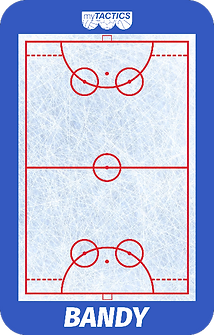
We have also included the increasingly popular sport of floorball, also known as floorball, in our range. Our floorball tactic boards are magnetic on both sides, can be written on and wiped off again and can be designed completely freely and individually. No matter what your wishes are, we will design your unique board with and for you.
What is floorball
Floorball (Swedish/Norwegian: innebandy, Finnish: salibandy) is a team sport from the stickball family. Via bandy, it is derived from field hockey, from which roller field hockey and ice hockey also originated. Floorball was developed jointly in Sweden, Finland and Switzerland in the 1970s, including by the Swiss team manager of EHC Kloten, Rolf "Hurti" Wiedmer. It is a game similar to indoor field hockey, but is much more similar to ice hockey, as it can also be played behind the goals and the entire pitch is surrounded by a board. The stick is equipped with a larger blade than in field or indoor field hockey. Floorball is currently the most widespread sport with tens of thousands of players in Sweden, Finland, the Czech Republic and Switzerland.
Floorball pitch
In floorball, a distinction is made between a large pitch and a small pitch. There are always six bullpen points on the pitch. There is a center point in the middle, which is used for the face-off. Next to the pitch are two penalty benches, a players' secretary's office and two players' benches.
The large pitch is surrounded by a 50 cm high, rounded board. The pitch is 40 m long and 20 m wide. It is recommended to leave a fall space of at least 50 cm.
The small pitch is surrounded by a rounded board, which must be 50 cm high. The pitch has a length of 24 m and a width of 14.5 m.[3] As with the large pitch, there must be a fall space of 50 cm. A maximum of 2 pitches may be set up in one hall.
Rules
The rules of floorball are stricter than those of ice hockey, although ice hockey is played in a much more physical manner. In floorball, only shoulder-to-shoulder pressure is permitted. In principle, the ball may only be played with the floorball stick. However, you are also allowed to play a foot pass. If a player plays the ball with his hands or head, this results in a direct free hit. It is also forbidden to jump into the air during the game in order to receive the ball. When a floorball player shoots the ball, he must ensure that the blade of the floorball stick never swings out higher than his hip. When receiving the ball high, the blade may only be raised up to the knees. The stick may not be lifted higher than hip height
Hard body contact (board checks, etc.) such as in ice hockey is prohibited in floorball, as is pushing and lifting the stick. If such an offense is committed, it may be punished with a two-minute penalty, meaning that the team must play with one less field player for two minutes. A five-minute penalty may also be imposed for excessively harsh offenses. Play is usually restarted with a free hit after a penalized offence. It must always be ensured that the team that caused the free hit keeps its distance from the ball (small pitch at least two meters, large pitch at least three meters). If an opposing player is too close to the ball when the free hit is taken, a two-minute penalty is imposed. In the case of a free hit, care must also be taken to ensure that it is executed quickly, otherwise the free hit will be awarded to the other team. In particular, stick hits and stick throws are prohibited. Both the outfield players and the goalkeeper may be substituted at any time during the game in unlimited numbers and with unlimited frequency. Since the 2004 World Championship, goalkeepers are prohibited from receiving a teammate's back pass with their hands. The curvature of the stick blade must not be more than three centimetres so that the ball cannot be picked up and carried around too easily.
Source: Wikipedia



